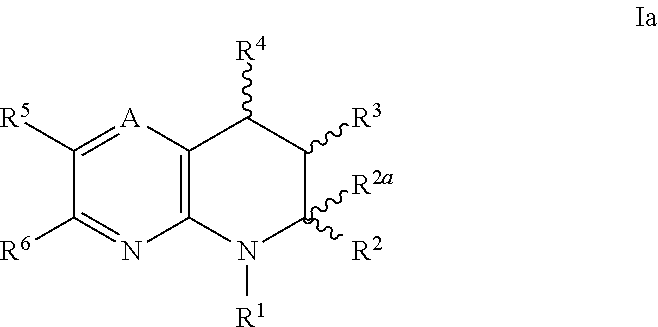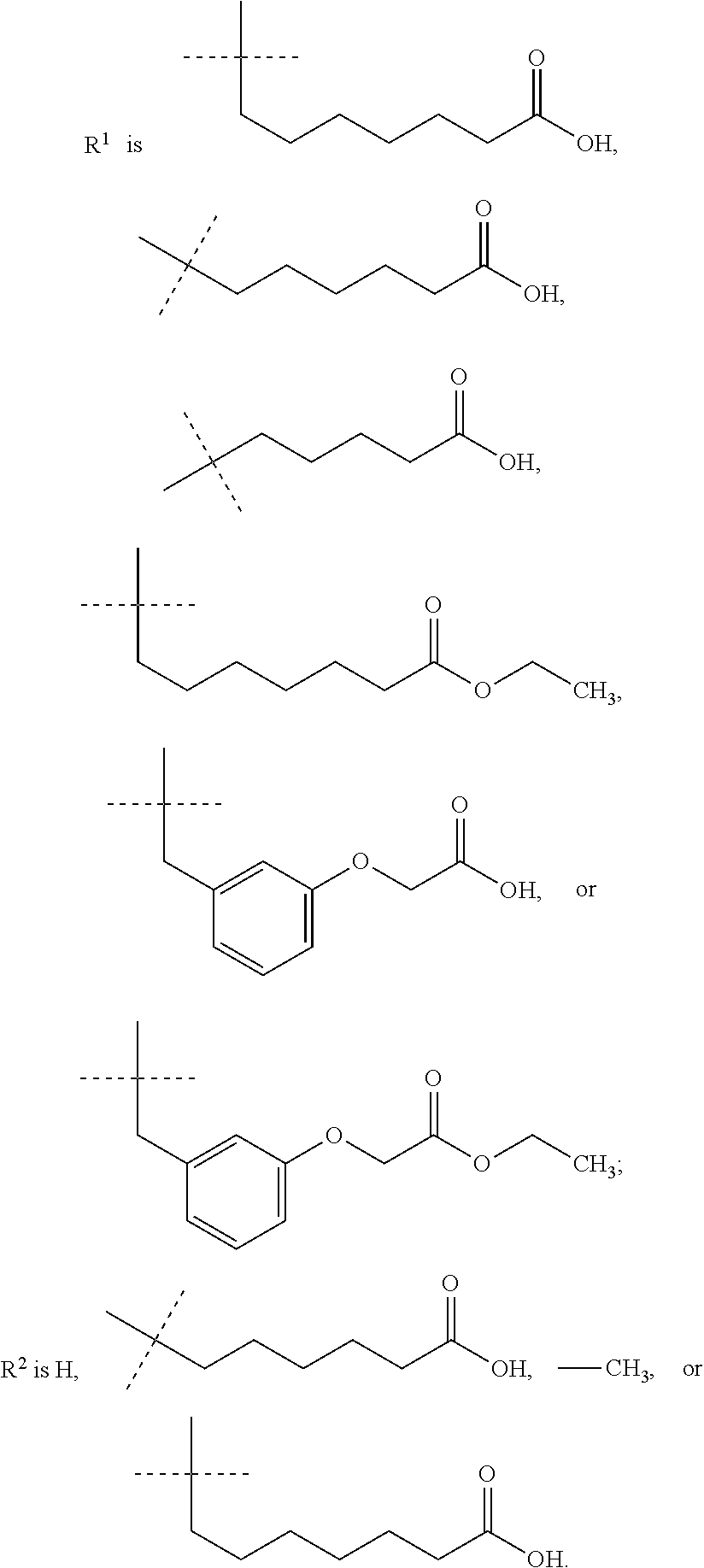IP receptor agonist heterocyclic compounds
a technology of ip receptor and heterocyclic compounds, which is applied in the direction of biocide, drug composition, cardiovascular disorder, etc., can solve the problems of prostacyclin analogues, not used as frontline therapy, and tolerated but can have limited efficacy
- Summary
- Abstract
- Description
- Claims
- Application Information
AI Technical Summary
Problems solved by technology
Method used
Image
Examples
example 1.1
7-(6,7-Diphenyl-3,4-dihydro-1,8-naphthyridin-1(2H)-yl)heptanoic acid
[0416]
Step 1: Ethyl 7-(6,7-diphenyl-3,4-dihydro-1,8-naphthyridin-1(2H)-yl)heptanoate
[0417]A solution of 6,7-diphenyl-1,2,3,4-tetrahydro-[1,8]naphthyridine (Intermediate B) (200 mg, 0.698 mmol) in dry NMP (1 ml) under N2 was treated with cesium carbonate (910 mg, 2.79 mmol) and ethyl 7-bromoheptanoate (0.544 ml, 2.79 mmol). The reaction mixture was stirred at 120° C. for 1 h and a further 3 h at 140° C. After cooling to room temperature, the mixture was partitioned between EtOAc and water. The organic portion was washed with brine, dried over MgSO4, filtered and concentrated in vacuo. Purification of the crude product by chromatography on silica eluting with 4:1 iso-hexane / EtOAc afforded a pink oil residue.
[0418]The residue was loaded onto an Isolute™ SCX-2 cartridge and eluted with MeOH followed by 2M NH3 in MeOH. The methanolic ammonia fractions were concentrated in vacuo and dried under vacuum at 40° C. to afford ...
example 2.1 and 2.2
Enantiomer 1 and Enantiomer 2 of 6-(1-Methyl-6,7-diphenyl-1,2,3,4-tetrahydro-1,8-naphthyridin-2-yl)hexanoic acid
Step 1: 7-Chloro-2,3-diphenyl-1,8-naphthyridine
[0425]POCl3 (10 ml, 107 mmol) was added dropwise to a mixture of 6,7-diphenyl-1,8-naphthyridine 1-oxide and 2,3-diphenyl-1,8-naphthyridine 1-oxide (Intermediates C) (3 g, 10.06 mmol) at 0° C. The reaction mixture was allowed to warm at room temperature and heated at 100° C. for 2 h. The mixture was poured carefully onto ice / water and the pH was adjusted to pH 8-9 by addition of Na2CO3 (solid) portionwise. The aqueous layer was separated and extracted with DCM (3×150 ml). The organic portions were combined and washed with brine, dried over MgSO4, filtered and concentrated in vacuo to afford a brown oil. Purification of the crude oil by chromatography on silica eluting with 0-50% EtOAc in iso-hexane afforded 7-chloro-2,3-diphenyl-1,8-naphthyridine and 5-chloro-2,3-diphenyl-1,8-naphthyridine:
7-Chloro-2,3-diphenyl-1,8-naphthyridin...
example 2.2
[0447]Enantiomer 2 of 6-(1-methyl-6,7-diphenyl-1,2,3,4-tetrahydro-1,8-naphthyridin-2-yl)hexanoic acid was prepared analogously to Enantiomer 1 from the appropriate starting compound:
[0448]LCMS Rt=1.36 mins, [M+H]+415.3, Method 2minLC_v002.
[0449]1H NMR (400 MHz, DMSO-d6) δ 12.03 (1H, s), 7.35-7.2 (9H, m), 7.14 (2H, m), 3.51 (1H, m), 3.18 (3H, s), 2.8 (2H, m), 2.27 (2H, t), 2.01 (1H, m), 1.82 (1H, m), 1.72 (1H, m), 1.59 (2H, m), 1.4-1.5 (5H, m).
[0450]The compounds of the following tabulated Examples (Table 3) were prepared by a similar method to that of Example 2.1 and 2.2 by replacing (6-ethoxy-6-oxohexyl)zinc(II) bromide with the appropriate organozinc derivative.
TABLE 3Ex.StructureName[M + H]+ / NMR2.3Enantiomer 1 of 7-(1- Methyl-6,7-diphenyl- 1,2,3,4-tetrahydro- [1,8]naphthyridin-2- yl)-heptanoic acidRt = 1.4 mins; [M + H]+ 429.3, Method 2minLC.v002 1H NMR (400 MHz, DMSO-d6) δ 7.46 (1H, m), 7.1-7.25 (10H, m), 3.42 (1H, m), 3.23 (3H, m), 2.82 (1H, m), 2.72 (1H, m), 2.36 (2H, m), 1.97...
PUM
| Property | Measurement | Unit |
|---|---|---|
| Temperature | aaaaa | aaaaa |
| Temperature | aaaaa | aaaaa |
| Temperature | aaaaa | aaaaa |
Abstract
Description
Claims
Application Information
 Login to view more
Login to view more - R&D Engineer
- R&D Manager
- IP Professional
- Industry Leading Data Capabilities
- Powerful AI technology
- Patent DNA Extraction
Browse by: Latest US Patents, China's latest patents, Technical Efficacy Thesaurus, Application Domain, Technology Topic.
© 2024 PatSnap. All rights reserved.Legal|Privacy policy|Modern Slavery Act Transparency Statement|Sitemap



